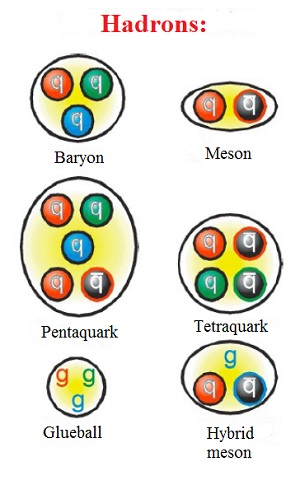Baryons Ц are massive building blocks of matter that our Universe consists of. Indeed, protons and neutrons
(often these two particles are called i nucleon), which form the nuclei of atoms of chemical elements, are representatives of this particular
category of particles. Nucleons are almost 2000 times heavier than electrons, which also are parts of atoms. The very name "baryon",
proposed in 1955 by A. Pais, comes from the Greek word "heavy" (βαρυς, baris). All elementary particles, which were known that time,
had smaller masses with respect to baryons.
The Laboratory of Baryon Physics (LBP) of the Department of High Energy Physics of the Institute is performing researches on the properties
of this family of elementary particles. First, it is necessary to describe the place of baryons in the systematics of elementary particles.
This will help to understand deeper a set of scientific problems the LBP employees are working on. The theory describing the microworld is called
the Standard Model of Particle Physics (SM). This theory describes the interaction of known truly elementary particles (see figure).
SM particles can be divided into particles of matter (quarks and leptons), particles, which carry interaction (so-called gauge bosons),
and the Higgs boson, which stands somewhat apart.

Quarks are the only particles, which participate in all three interactions included in the SM. Due to the peculiar features of the strong
interaction, quarks, antiquarks (each of the SM particles has an antiparticle) and gluons (elementary particle that acts as the exchange particle
for the strong force between quarks) can only be observed as part of other composite elementary particles - hadrons. Baryons are just one
of two known types of hadrons. They are characterized by the fact that the number of quarks in their composition is three more than the number
of antiquarks. Mesons, another type of hadrons, are characterized by the same number of quarks and antiquarks that make up these elementary particles.

For a long time, only baryons consisting of three quarks were known. At the same time, a detailed exact (quantitative) theory of hadrons does not yet exist.
New more accurate experimental data are needed to build it, as well as to clarify the characteristics of particles already known to physicists.
Such properties include masses, lifetimes, quantum numbers, as well as the probabilities of decays into different decay channels.
These measurements are exactly, what the LBP physicists are doing in the LHCb experiment at the Large Hadron Collider.
The focus of the LHCb is on particles that contain c (physicists call it charm, charmed or charming) or b (beauty, beautiful) quarks.
These are rather heavy elementary particles. So, the mass of the c-quark is slightly larger than the mass of the proton
(a particle consisting of light quarks u and d), and the b-quark is four times more massive. It turns out that the properties of baryons,
which include heavy quarks, are easier calculate within theory. Therefore, such baryons are a bridge leading theoretical physicist to the construction
of an exact theory of hadrons. You can read more about these experimental studies in the
notes on the website of the Institute (in Russian).
The existence of another type of baryons (pentaquarks), which consist of four quarks and one antiquark, was first experimentally proven by
the LHCb collaboration. You can read more about these studies in the notes on the NRC KI Ц PNPI website
( 1 ,
2 )..
The instrumental contribution of PNPI into LHCb experiment is the development, construction, commissioning and operation, as well as the
modernization of the Muon system of the experiment.
The laboratory is involved not only in the research of heavy baryons. The scientific interests of the LBP physicists also include the study
of the properties of the only stable baryon, the proton. The properties of the proton have been well studied experimentally, but theory is not yet
able to calculate its characteristics based on the properties of the strong interaction, though this is a goal. Recently, the so-called the proton
radius puzzle has been added to these difficulties. In 2010, a group of physicists which studied muonic hydrogen, the bound state of the proton
and the muon (the heavy analogue of the electron), reported that they had obtained a much smaller proton radius with respect to suggested by experiments
on electron-proton scattering and ordinary hydrogen spectroscopy. Such a large discrepancy cannot be explained by statistical uncertainty
and several scenarios for solving this puzzle are now being considered. First, the theoretical calculations are being rechecked,
because the extraction of the radius using the spectroscopy of ordinary and muonic hydrogen relies on them. So far, the prevailing opinion
is that the systematic uncertainties of the calculations do not exceed one tenth of the observed effect. Secondly, it is possible and necessary
to improve the accuracy of determining the proton radius using scattering experimental technique. There also remains a tempting possibility
to explain the observed discrepancy by the manifestation of new yet unknown fundamental interactions that violate the universality of interactions
between the proton and leptons (electron and muon). At present, however, such explanations are mere hypotheses that need to be tested by experiment.
Recently, HEPD physicists (including LBP ones) in collaboration with the University of Mainz (Germany) are developing a new experiment to measure
the elastic scattering of electrons on a proton. Record-breaking accuracy of results is required. The main feature of the new experiment
is the
active target method,
when a volume of hydrogen under a pressure of 20 bar serves both as a target and as a detector of recoil protons.